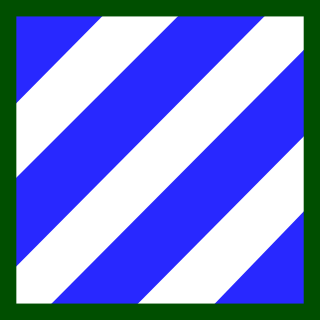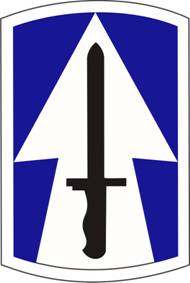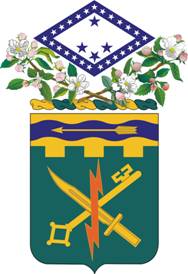
The 32nd Infantry Brigade Combat Team is an infantry brigade combat team (IBCT) in the United States Army National Guard. It was formed from the inactivated 32nd Infantry Division in 1967. It is the largest unit in the Wisconsin National Guard.

The 41st Infantry Brigade Combat Team ("Sunset") is an element in the Oregon Army National Guard. Headquartered at Camp Withycombe, Clackamas, Oregon, it was part of the 7th Infantry Division based at Ft. Carson in Colorado. The brigade traces its lineage back to the 41st Infantry Division.

The Florida Army National Guard is Florida's component of the United States Army and the United States National Guard. In the United States, the Army National Guard comprises approximately one half of the federal army's available combat forces and approximately one third of its support organization. Federal coordination of various state National Guard units are maintained through the National Guard Bureau. The Florida Army National Guard was composed of approximately 10,000 soldiers. The main state training grounds is Camp Blanding.

Below is an estimated list of the major units deployed within the Multi-National Force – Iraq and other United States military units that were operating in Iraq under the U.S. Central Command (USCENTCOM) in 2009, during the Iraq War.

The 256th Infantry Brigade Combat Team is a modular infantry brigade combat team (IBCT) of the Louisiana Army National Guard. It is headquartered in Lafayette, Louisiana. Currently the brigade is part of the 28th Infantry Division of the Pennsylvania Army National Guard.

The Georgia Army National Guard is the Army National Guard component of the Georgia National Guard, administratively part of the Georgia Department of Defense. It consists of more than 11,100 citizen-soldiers training in more than 79 hometown armories and regional facilities across the state. Georgia’s Army Guard is the sixth largest in the nation and includes combat, combat support and combat service support units.

The 37th Infantry Brigade Combat Team (Buckeye) is an infantry brigade combat team of the United States Army National Guard with the brigade headquarters, cavalry squadron, field artillery battalion, engineer battalion, one infantry battalion, and support battalion stationed in Ohio, one infantry battalion and military intelligence company stationed in Michigan, and a third infantry battalion stationed in South Carolina. The headquarters of the 37th IBCT traces its lineage and honors back to the headquarters of the 37th Infantry Division.

The 3rd Brigade Combat Team, 1st Cavalry Division is a combined arms armored brigade of the 1st Cavalry Division based in Fort Cavazos, TX. Major equipment includes the M1A2SEP Tanks, M2A3 & M3A3 Bradley infantry fighting vehicles, M109A7 Paladin howitzers, and M1114 up-armored Humvees.

The 48th Infantry Brigade Combat Team is a modular infantry brigade of the Georgia Army National Guard. One of the oldest units in U.S. Army history, the lineage of the 48th Infantry Brigade can be traced back to 1825. It is one of few units in the US military that also saw service as a unit of the Confederate States of America during the American Civil War. Today, the 48th IBCT is part of the U.S. Army's "Associated Units" program where it is aligned under the 3rd Infantry Division, a combined arms combat maneuver unit of the Regular Army.

The 76th Infantry Brigade Combat Team is a modular infantry brigade of the United States Army National Guard of Indiana. It is headquartered in Lawrence Readiness Training Center, on the grounds of Fort Benjamin Harrison.

The 151st Cavalry Regiment was a United States Army cavalry regiment represented in the Arkansas Army National Guard by 1st Squadron, 151st Cavalry Regiment, headquartered in Warren, Arkansas, an element of the 39th Infantry Brigade Combat Team.

The 1st Battalion, 153d Infantry Regiment , is an infantry battalion of the Arkansas Army National Guard, headquartered at Malvern, assigned to the 39th Infantry Brigade Combat Team. The 1–153rd has deployed companies in support of the Multi-National Security Force to Bosnia and to Saudi Arabia as part of Operation Southern Watch. 1st Battalion, 153rd Infantry has twice deployed as a battalion for Operation Iraqi Freedom, once from 2004–05 and a second time in 2008. The battalion was awarded the Meritorious Unit Citation for the period, 17 March 2004 – 23 March 2005.

The 2d Battalion, 153d Infantry Regiment , is an infantry battalion of the Arkansas Army National Guard, headquartered at Searcy, assigned to the 39th Infantry Brigade Combat Team. During World War II, the battalion was stationed in the Aleutian Islands. Following the attacks of 11 September 2001, the 2nd Battalion, 153rd Infantry, nicknamed the "Gunslingers", deployed to the Sinai on a peace keeping mission in order to free regular army soldiers for service elsewhere. The soldiers of the 2–153rd deployed under the flag of the 3rd Battalion, 153rd Infantry during Operation Iraqi Freedom II. The battalion provided disaster relief operations to the citizens of Louisiana in the aftermath of Hurricane Katrina. The Gunslingers were deployed to Iraq a second time in 2008 as a security forces battalion and conducted convoy security operations in western Iraq. Most recently, members of the 2-153rd deployed to Central America as part of the Regionally aligned forces mission in order to carry out a train-the-trainer and security cooperation mission in Guatemala, Honduras and El Salvador. See also

3rd Battalion, 153rd Infantry Regiment was a United States infantry battalion, headquartered at Warren, Arkansas, assigned to the 39th Infantry Brigade Combat Team of the Arkansas Army National Guard until it was deactivated on 5 September 2005. The history of the 3rd Battalion, 153rd Infantry as an individual battalion begins with the reorganization of the 39th Infantry Division in 1967 and the creation of the 39th Infantry Brigade (Separate). For history of the 3rd Battalion prior to 1967, see 153rd Infantry Regiment and 39th Infantry Division.

39th Brigade Support Battalion is an element of the 39th Infantry Brigade Combat Team (IBCT), of the Arkansas Army National Guard. The battalion is headquartered at Hazen, Arkansas. The 39th Support Battalion was constituted on 2 November 1967 from existing units in central Arkansas and assigned to the 39th Infantry Brigade with headquarters in Hazen. Headquarters and Headquarters Battery, 2nd Battalion, 206th Field Artillery Regiment, at Hazen was reorganized and re-designated as the Headquarters and Headquarters Company, 39th Support Battalion.

The 39th Infantry Brigade Combat Team's Special Troops Battalion was headquartered in Conway, Arkansas and was an element of the Arkansas Army National Guard. On 15 September 2018, the 39th Special Troops Battalion was reflagged as the 239th Brigade Engineer Battalion, an element of the 39th Infantry Brigade Combat Team.

The 124th Infantry Regiment is a parent regiment of the United States Army, represented in the Florida Army National Guard by the 1st Battalion headquartered in Miramar and 2nd Battalion at Orlando. The two Battalions are elements of the 53rd Infantry Brigade Combat Team.

First Squadron, 153rd Cavalry Regiment "Darkhorse" is an element of the Florida Army National Guard, headquartered in Panama City, Florida with units throughout the Panhandle. It was formerly 3rd Battalion, 124th Infantry and officially converted to cavalry on 1 September 2007 when the 53rd Infantry Brigade converted from a "separate brigade" to the brigade combat team structure.

The Governor's Guards is a historic unit of the Florida Army National Guard, stationed in Tallahassee, Florida. Its current designation is Troop C, 1st Squadron, 153rd Cavalry. The unit has one of the oldest continuous lineages in the Florida National Guard. In 1857, Captain John Parkhill, his brother Samuel M. Parkhill, and Theordore Brevard, Jr. formed a mounted company of "Leon Volunteers" to fight in the Third Seminole War, where John Parkhill was killed in action. John Parkhill's cousin, Captain George W. Parkhill and his brother, Richard C. Parkhill formed a new company called the "Governor's Guards" circa 1859-1860 which later changed its name to "Howell Guards" and fought with the Second Florida Infantry during the Civil War. After the war, the company reorganized as "Governor's Guards", a local militia company, under the command of Captain Alexander Moseley and have had a near-continuous lineage henceforth. The Governor's Guards served as an infantry unit for most of its existence, including in the Civil War, World War I, World War II, the Iraq War and the Global War on Terrorism. The unit consolidated with the Franklin Guards, a detachment in Apalachicola and since 2007 has been Charlie Troop, a dismounted infantry reconnaissance troop.

The 44th Infantry Brigade Combat Team is an infantry brigade combat team of the New Jersey National Guard. It is headquartered at the Lawrenceville Armory in Lawrenceville, New Jersey, United States. The 44th Infantry Brigade Combat Team is the major unit of the New Jersey Army National Guard. It consists of three light infantry battalions, a field artillery battalion, a cavalry squadron, an engineer battalion, and a support battalion.



















